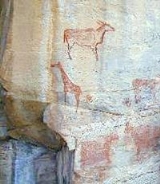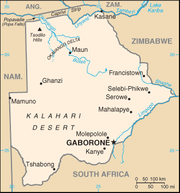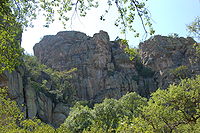
Tsodilo
Encyclopedia
Tsodilo is a UNESCO
World Heritage Site
located in northwestern Botswana
. It was inscribed in 2001 due to its unique religious and spiritual significance to local peoples, as well as its unique record of human
settlement over many millennia. It contains over 4,500 rock paintings in an area of approximately 10 km² within the Kalahari Desert
.
There is a managed campsite between the two largest hills, with showers and toilets. It is near the most famous of the San paintings at the site, the Laurens van der Post Panel. The hills can be reached via a good graded dirt road and are about 40 km from Shakawe
. Also by the campsite is a small museum. There is also an airstrip.
peoples of the Kalahari. They believe the hills are a resting place for the spirits of the deceased and that these spirits will cause misfortune and bad luck if anyone hunts or causes death near the hills. The San people believe these hills to be the site of first Creation. Factually, the San people painted more than 4500 rock paintings against the magnificent stone faces of the Tsodilo Hills, making it one of the most historically significant art sites in the world. The San did most of the paintings, although there are a few by Bantu-speakers whose style differs to that of the San. The exact age of the paintings is not known although some are thought to be more than 20,000 years old. The hills contain 500 individual sites representing thousands of years of human habitation. .
The hills are referred to by human attributes - male, female, child and the male's first wife. The second tallest hill is referred to as the female. The San people believe that the caves and caverns of this hill, the "Female" hill, are the resting places of the deceased and various gods who rule the world from here. The people of Hambukushu believe that their god, Nyambe, originally lowered their tribe and livestock to earth on the female hill. Their supporting evidence are hoof-prints clearly etched into a rock, high on the hill. (The wordTsodilo is derived from the Hambukushu word 'sorile' which means sheer.) In the northwest part of the female hill, some distance up from ground level is an old mine that has filled with water. This water is considered to be holy water and confers good luck on those that wash their faces with it. The most sacred place is near the top of the "Male" hill, the biggest rock, where it is said that the First Spirit knelt and prayed after creating the world. The San believe that you may still see the impression of the First Spirits' knees in the rock. The smallest hill is the 'child'. Finally, according to legend, the fourth hill was the male hill's first wife, whom he left for a younger woman, and who now prowls in the background.


There are recently installed trails and signs, but the paintings are difficult to find without a knowledgeable guide. In fact, visitors are obliged to take one of the local guides. This provides money to the local economy and helps protect the site.
The massive amount of rock art testifies to its significance to the human family. Therefore, UNESCO has established the Tsodilo hills as a World Cultural Heritage site.
stated that 70,000-year-old artifacts and a rock resembling a python's head representing the first known human rituals had been discovered. She also backed her interpretation of the site as a place of ritual based on other animals portrayed: "In the cave, we find only the San people's three most important animals: the python, the elephant, and the giraffe. Since then some of the archaeologists involved in the original investigations of the site in 1995 and 1996 have challenged these interpretations. They point out that the indentations (known by archaeologists as cupules) described by Coulson do not necessarily all date to the same period and that "many of the depressions are very fresh while others are covered by a heavy patina." Other sites nearby (over 20) also have depressions and do not represent animals. The Middle Stone Age
radiocarbon
and thermoluminescence dating
for this site does not support the 70,000 year figure, suggesting much more recent dates.
Discussing the painting, the archaeologists say that the painting described as an elephant is actually a rhino, that the red painting of a giraffe is no older than 400 AD and that the white painting of the rhino is more recent, and that experts in rock art believe the red and white paintings are by different groups. They refer to Coulson's interpretation as a projection of modern beliefs on to the past and call Coulson's interpretation a composite story that is "flatout misleading". They respond to Coulson's statement that these are the only paintings in the cave by saying that she has ignored red geometric paintings found on the cave wall.
They also discuss the burned Middle Stone Age points, saying that there is nothing unusual in using nonlocal materials. They dismiss the claim that no ordinary tools were found at the site, noting that the many scrapers that are found are ordinary tools and that there is evidence of tool making at the site. Discussing the 'secret chamber', they point to the lack of evidence for San shamans using chambers in caves or for this one to have been used in such a way.
UNESCO
The United Nations Educational, Scientific and Cultural Organization is a specialized agency of the United Nations...
World Heritage Site
World Heritage Site
A UNESCO World Heritage Site is a place that is listed by the UNESCO as of special cultural or physical significance...
located in northwestern Botswana
Botswana
Botswana, officially the Republic of Botswana , is a landlocked country located in Southern Africa. The citizens are referred to as "Batswana" . Formerly the British protectorate of Bechuanaland, Botswana adopted its new name after becoming independent within the Commonwealth on 30 September 1966...
. It was inscribed in 2001 due to its unique religious and spiritual significance to local peoples, as well as its unique record of human
Human
Humans are the only living species in the Homo genus...
settlement over many millennia. It contains over 4,500 rock paintings in an area of approximately 10 km² within the Kalahari Desert
Kalahari Desert
The Kalahari Desert is a large semi-arid sandy savannah in Southern Africa extending , covering much of Botswana and parts of Namibia and South Africa, as semi-desert, with huge tracts of excellent grazing after good rains. The Kalahari supports more animals and plants than a true desert...
.
Geography
There are four chief hills. The highest is 1,400 metres AMSL and located at 18°46′18"S 21°45′15"E. This is the highest point in Botswana. The four hills are commonly described as the "Male", this is the highest, the "Female", "Child" and an un-named knoll.There is a managed campsite between the two largest hills, with showers and toilets. It is near the most famous of the San paintings at the site, the Laurens van der Post Panel. The hills can be reached via a good graded dirt road and are about 40 km from Shakawe
Shakawe
Shakawe is a village located in the northwest corner of Botswana. It is located at the beginning of the Okavango Delta, close to Namibia and Angola. Shakawe is awakening from its former status as a sleepy little outpost on the Okavango.For travellers, Shakawe means a Botswana entry or exit stamp...
. Also by the campsite is a small museum. There is also an airstrip.
Cultural Significance
These hills are of great cultural and spiritual significance to the SanBushmen
The indigenous people of Southern Africa, whose territory spans most areas of South Africa, Zimbabwe, Lesotho, Mozambique, Swaziland, Botswana, Namibia, and Angola, are variously referred to as Bushmen, San, Sho, Barwa, Kung, or Khwe...
peoples of the Kalahari. They believe the hills are a resting place for the spirits of the deceased and that these spirits will cause misfortune and bad luck if anyone hunts or causes death near the hills. The San people believe these hills to be the site of first Creation. Factually, the San people painted more than 4500 rock paintings against the magnificent stone faces of the Tsodilo Hills, making it one of the most historically significant art sites in the world. The San did most of the paintings, although there are a few by Bantu-speakers whose style differs to that of the San. The exact age of the paintings is not known although some are thought to be more than 20,000 years old. The hills contain 500 individual sites representing thousands of years of human habitation. .
The hills are referred to by human attributes - male, female, child and the male's first wife. The second tallest hill is referred to as the female. The San people believe that the caves and caverns of this hill, the "Female" hill, are the resting places of the deceased and various gods who rule the world from here. The people of Hambukushu believe that their god, Nyambe, originally lowered their tribe and livestock to earth on the female hill. Their supporting evidence are hoof-prints clearly etched into a rock, high on the hill. (The wordTsodilo is derived from the Hambukushu word 'sorile' which means sheer.) In the northwest part of the female hill, some distance up from ground level is an old mine that has filled with water. This water is considered to be holy water and confers good luck on those that wash their faces with it. The most sacred place is near the top of the "Male" hill, the biggest rock, where it is said that the First Spirit knelt and prayed after creating the world. The San believe that you may still see the impression of the First Spirits' knees in the rock. The smallest hill is the 'child'. Finally, according to legend, the fourth hill was the male hill's first wife, whom he left for a younger woman, and who now prowls in the background.


Rock Paintings
According to UNESCO, there are over 4500 rock art paintings in the Tsodilo Hills. Most of the San rock paintings are found on the "Female" hill, the most famous being the "Whale" painting, "Two Rhinos" and the "Lion" on the Eastern face of the "Father". Some of the paintings have been dated to be as early as 24,000 years before present. There are numerous paintings, but relatively few on the outlying hills. Indeed there are so many paintings in obscure places that it is very unlikely they have all been discovered or documented.There are recently installed trails and signs, but the paintings are difficult to find without a knowledgeable guide. In fact, visitors are obliged to take one of the local guides. This provides money to the local economy and helps protect the site.
The massive amount of rock art testifies to its significance to the human family. Therefore, UNESCO has established the Tsodilo hills as a World Cultural Heritage site.
Alleged as site of earliest known ritual
In 2006 the site known as Rhino Cave became prominent in the media when Sheila Coulson of the University of OsloUniversity of Oslo
The University of Oslo , formerly The Royal Frederick University , is the oldest and largest university in Norway, situated in the Norwegian capital of Oslo. The university was founded in 1811 and was modelled after the recently established University of Berlin...
stated that 70,000-year-old artifacts and a rock resembling a python's head representing the first known human rituals had been discovered. She also backed her interpretation of the site as a place of ritual based on other animals portrayed: "In the cave, we find only the San people's three most important animals: the python, the elephant, and the giraffe. Since then some of the archaeologists involved in the original investigations of the site in 1995 and 1996 have challenged these interpretations. They point out that the indentations (known by archaeologists as cupules) described by Coulson do not necessarily all date to the same period and that "many of the depressions are very fresh while others are covered by a heavy patina." Other sites nearby (over 20) also have depressions and do not represent animals. The Middle Stone Age
Middle Stone Age
The Middle Stone Age was a period of African Prehistory between Early Stone Age and Late Stone Age. It is generally considered to have begun around 280,000 years ago and ended around 50-25,000 years ago. The beginnings of particular MSA stone tools have their origins as far back as 550-500,000...
radiocarbon
Radiocarbon dating
Radiocarbon dating is a radiometric dating method that uses the naturally occurring radioisotope carbon-14 to estimate the age of carbon-bearing materials up to about 58,000 to 62,000 years. Raw, i.e. uncalibrated, radiocarbon ages are usually reported in radiocarbon years "Before Present" ,...
and thermoluminescence dating
Thermoluminescence dating
Thermoluminescence dating is the determination, by means of measuring the accumulated radiation dose, of the time elapsed since material containing crystalline minerals was either heated or exposed to sunlight...
for this site does not support the 70,000 year figure, suggesting much more recent dates.
Discussing the painting, the archaeologists say that the painting described as an elephant is actually a rhino, that the red painting of a giraffe is no older than 400 AD and that the white painting of the rhino is more recent, and that experts in rock art believe the red and white paintings are by different groups. They refer to Coulson's interpretation as a projection of modern beliefs on to the past and call Coulson's interpretation a composite story that is "flatout misleading". They respond to Coulson's statement that these are the only paintings in the cave by saying that she has ignored red geometric paintings found on the cave wall.
They also discuss the burned Middle Stone Age points, saying that there is nothing unusual in using nonlocal materials. They dismiss the claim that no ordinary tools were found at the site, noting that the many scrapers that are found are ordinary tools and that there is evidence of tool making at the site. Discussing the 'secret chamber', they point to the lack of evidence for San shamans using chambers in caves or for this one to have been used in such a way.

